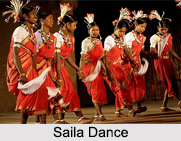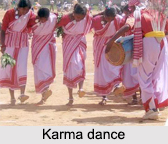 Folk dance of Chhattisgarh are performed as a part of customs and are performed in worship to Gods or signify the changing of seasons. There are many types of tribal communities in India and Chhattisgarh is home to many of them. In fact, this state has India`s oldest tribal communities and it is safe to assume that the earliest tribals have been living in Bastar for over 10,000 years. Each of these communities has its own rich and distinctive history and culture of music, dance, dress and food. India is known for her festivals and these are evident in Chhattisgarh festivals too. An explosion of music and colour, a generous dose of spirituality, a liberal helping of sheer energy all topped with age-old tribal traditions. The Saila Dance is one of those many dances in this state, which is famous for its uniqueness.
Folk dance of Chhattisgarh are performed as a part of customs and are performed in worship to Gods or signify the changing of seasons. There are many types of tribal communities in India and Chhattisgarh is home to many of them. In fact, this state has India`s oldest tribal communities and it is safe to assume that the earliest tribals have been living in Bastar for over 10,000 years. Each of these communities has its own rich and distinctive history and culture of music, dance, dress and food. India is known for her festivals and these are evident in Chhattisgarh festivals too. An explosion of music and colour, a generous dose of spirituality, a liberal helping of sheer energy all topped with age-old tribal traditions. The Saila Dance is one of those many dances in this state, which is famous for its uniqueness.
The folk dances of Chhattisgarh are as follows:
Saila Dance: In the month of Aghan, the villagers go to the adjoining villages to perform the Saila Dance. The group of Saila Dancers go to each house and perform this dance. Young boys from the plains of Chhattisgarh perform, in order to have great enthusiasm and spirit after the post-harvest time. Saila in its simplest form is also performed as the Dasera dance that is always performed by the Baigas before festival of Diwali. The Saila dance is a stick-dance that is popular in many regions of the state, among the people of Sarguja, Chhindwara and Baitul districts. But in these places, Danda Nach or Dandar Pate is known as Saila. Saila dance can be performed in number of ways. Some of them are named as the Baithiki Saila, the Artari Saila, the Thadi Saila, the Chamka Kunda Saila, the Chakramar Saila (lizard`s dance) and the Shikari Saila. Each form of variation is based on a certain theme and distinctive feature as its own identity. 
The dancers have small sticks in their hand and this stick is struck, next to the stick of the person who is dancing near to him. They move in circles in clockwise direction, and then they turn around and move anti-clockwise. The "Mandar" gives the beat to the dancers. When the beat becomes fast, the dancers also move faster. The sticks are once hit against each other, when the arms are stretched upwards and then when the arms come down. Hence, the Saila dance is performed with many variations in dancing style and pattern. Sometimes the dancers stand together, forming a circle. Here, each one stands on one leg and takes support by holding on to the man in front. Then they all dance together, or sometimes, they pair off or go around in a single or double line, climbing each other`s back. The climax in the performance of Saila is the great Snake dance.
Karma: Generally performed by tribal groups like Gonds, the Baigas and Oraons in Chhattisgarh. This dance type marks the end of rainy period and beginning of spring.
Sua Nacha: It is generally called as Parrot dance and is performed in the event of Goura Marriage. It is a classic type of movement identified with love. The entertainers sing and move around, accompanied by loud forms of clapping.
Panthi Dance: Panthi Dance is one of the most significant forms of folk dance in this area. It is a famous ceremony of the Satnami community of Chhattisgarh. The community celebrates the birth anniversary of Guru Ghasidas on Maghi Purnima.
Gendi: Of all the dance forms, this one is pure enjoyable. The dancers are mounted on two long bamboo or just any fixed sticks and plan through the crowd of other Gendi (sticks) ridden dancers. Throbbing on the ground, maintaining outstanding balance as they bend to the tribal acoustics and percussions – this is one amazing folk dance which has managed to keep its tradition alive.



















